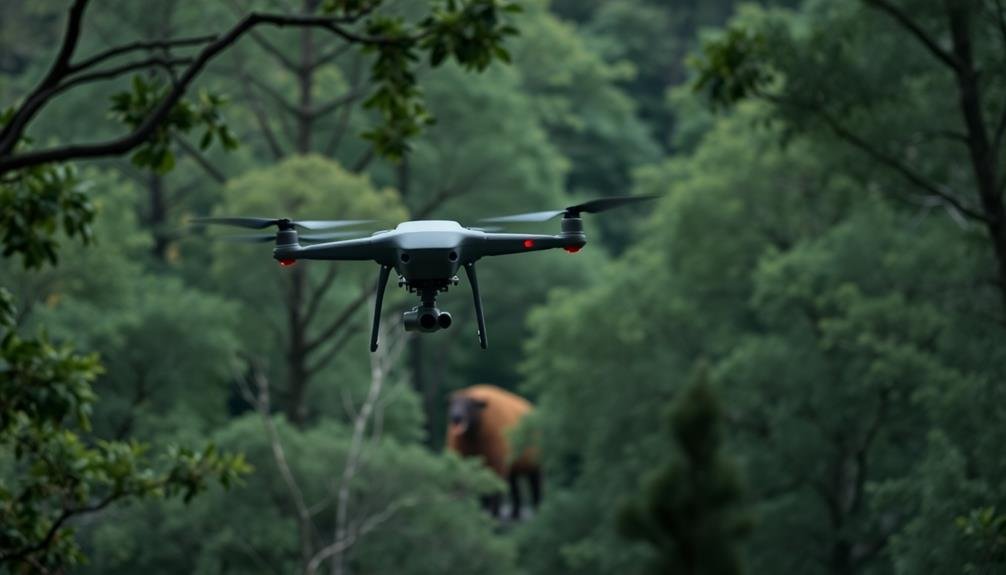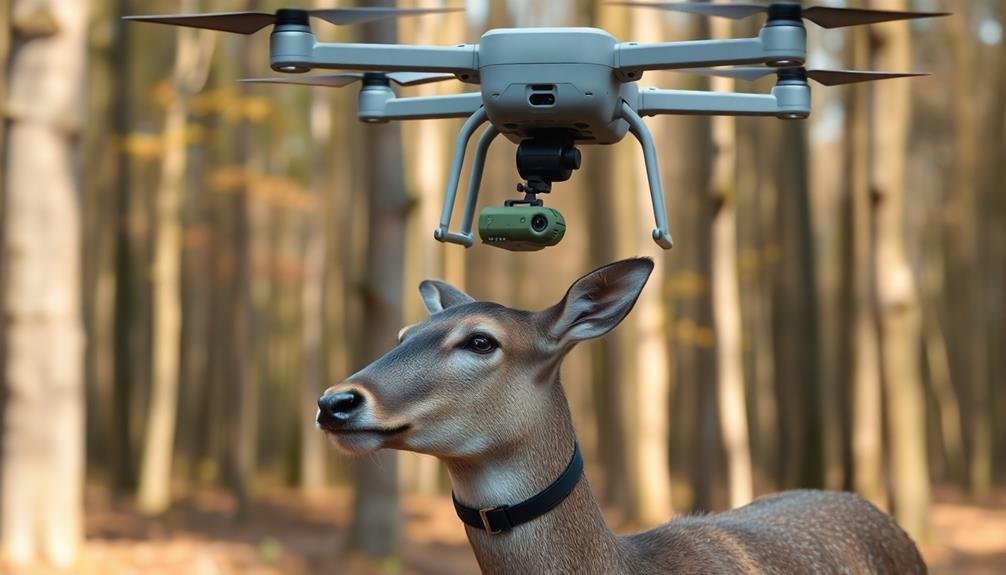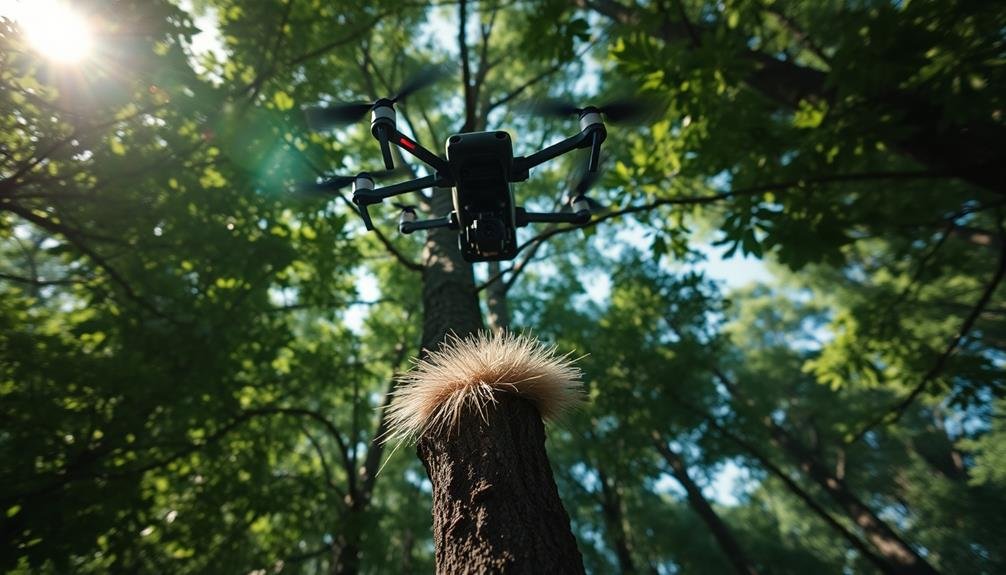Modern wildlife tagging techniques using UAVs have transformed animal research and conservation. You'll find aerial darting methods that allow safe, distant tagging with GPS trackers or biosampling devices. Net gun deployment from drones offers precise targeting for larger animals. UAVs can attach radio collars remotely, reducing stress on wildlife. Thermal imaging enhances detection capabilities, especially in low-light conditions. GPS tagging with drone assistance enables efficient monitoring in hard-to-reach habitats. Drone-delivered transponder implantation minimizes human-animal contact. These innovative approaches increase safety for researchers and animals alike while providing valuable data. Exploring further reveals even more cutting-edge techniques revolutionizing wildlife studies.
UAV-Based Aerial Darting Techniques

Revolutionizing wildlife tagging, UAV-based aerial darting techniques have emerged as a game-changer in animal research and conservation. These methods allow you to safely and efficiently tag animals from a distance, reducing stress on both wildlife and researchers.
UAVs equipped with dart-launching mechanisms can approach animals in hard-to-reach areas or dangerous terrains. You'll find that this technology is particularly useful for studying large mammals, such as elephants, rhinos, or big cats. The darts contain GPS trackers, biosampling devices, or tranquilizers, depending on your research needs.
To use this technique, you'll need to pilot the UAV close to the target animal and release the dart at the ideal moment. The dart's impact is cushioned to minimize harm, and it detaches after delivering its payload. You can then retrieve the dart using the UAV or ground teams.
This method offers several advantages over traditional tagging techniques. It's less invasive, reduces the risk of human-animal conflict, and allows for more precise targeting.
However, you'll need to take into account factors like wind speed, animal movement, and local regulations when implementing this approach.
Net Gun Deployment From Drones

You'll find that net gun designs for drone deployment require significant modifications to reduce weight and recoil.
When planning drone flights for net gun use, you must account for wind conditions, target animal behavior, and the added weight of the net gun system.
It's essential to follow strict animal safety protocols, ensuring proper net design and deployment techniques to minimize stress and potential injury to the wildlife you're tagging.
Net Gun Design Adaptations
The integration of net guns into UAV systems has sparked a wave of innovative adaptations. You'll find that these modifications focus on reducing weight, improving accuracy, and enhancing deployment mechanisms.
Lightweight materials like carbon fiber and high-strength polymers are now used in net gun construction, notably decreasing the overall payload without compromising durability.
To improve accuracy, designers have incorporated advanced targeting systems and stabilization technologies. These include laser rangefinders, wind sensors, and gyroscopic stabilizers that compensate for drone movement during flight.
You'll also see adjustable net configurations that allow for customization based on target species size and behavior.
Deployment mechanisms have evolved to include compressed air systems, which are quieter and more reliable than traditional powder charges. Some designs feature multiple-shot capabilities, allowing for quick follow-up attempts if needed.
Remote triggering systems have been refined, giving operators precise control over net deployment timing.
Safety features have also been enhanced, with fail-safe mechanisms and automatic release systems to prevent entanglement with the drone.
These adaptations have made net guns more effective and versatile tools for wildlife tagging from UAVs.
Drone Flight Considerations
When deploying net guns from drones, several vital flight considerations come into play. You'll need to carefully plan your flight path to guarantee ideal positioning for successful tagging.
Wind speed and direction are essential factors, as they can affect both your drone's stability and the net's trajectory. You must maintain a safe distance from the target animal to avoid startling it while still being close enough for accurate deployment.
The drone's altitude is another key consideration. Flying too high may reduce accuracy, while flying too low could pose risks to both the animal and the equipment. You'll need to balance these factors based on the specific species and terrain.
The drone's speed is also important; moving too fast can make it difficult to aim accurately, while hovering might alert the animal to your presence.
Battery life is a vital concern, as you'll need enough power for the entire operation, including travel to and from the tagging site.
Animal Safety Protocols
Animal safety is paramount when deploying net guns from drones. You'll need to follow strict protocols to guarantee the well-being of the target species. First, consider the animal's size and weight to select an appropriate net. The drone's altitude and approach angle are vital factors in minimizing stress and potential injury.
Before deploying the net gun, you must:
- Assess the terrain for obstacles
- Monitor the animal's behavior
- Calculate wind speed and direction
- Confirm a clear flight path for the drone
Here's a quick reference guide for net gun deployment:
| Factor | Consideration |
|---|---|
| Net size | Match to animal size |
| Drone altitude | 10-20 meters above target |
| Approach angle | 30-45 degrees |
| Wind speed | < 15 km/h |
| Capture area | Clear of obstacles |
After successful deployment, you'll need to quickly retrieve the animal to minimize stress. Have a trained wildlife handling team ready on the ground. They should assess the animal's condition, remove the net carefully, and apply any necessary tags or collars. Always prioritize the animal's welfare throughout the entire process, from planning to release.
Radio Collar Attachment via UAVs

Traditionally, attaching radio collars to wildlife required direct human intervention, often involving tranquilization and handling of animals. However, UAVs have revolutionized this process, allowing for remote collar attachment with minimal disturbance to the animals.
You'll find that UAV-assisted radio collar attachment offers several advantages:
- Reduced stress on animals
- Increased safety for researchers
- Access to hard-to-reach locations
- More efficient and cost-effective tagging operations
When using UAVs for radio collar attachment, you'll typically employ a specialized drone equipped with a collar deployment mechanism. As you pilot the UAV near the target animal, you'll use high-resolution cameras to guarantee precise positioning.
Once in place, you'll activate the deployment system, which gently drops the collar around the animal's neck.
It's important to note that this method isn't suitable for all species. You'll need to take into account factors such as animal size, behavior, and habitat when determining if UAV-assisted tagging is appropriate.
Additionally, you must adhere to strict regulations governing UAV use in wildlife research. Despite these limitations, UAV-assisted radio collar attachment represents a significant advancement in wildlife tracking technology, offering a less invasive and more efficient approach to studying animal populations.
Thermal Imaging for Wildlife Detection

Thermal imaging technology has revolutionized wildlife detection for UAV-based research. You'll find that modern UAVs equipped with thermal cameras can easily spot animals in dense forests, tall grasslands, or even underwater. These cameras detect heat signatures, allowing researchers to locate and track wildlife that might otherwise remain hidden.
When you're using thermal imaging for wildlife detection, you'll notice it's particularly effective at night or in low-light conditions. This capability extends research hours and improves data collection. You can identify different species based on their unique thermal profiles, which is especially useful for monitoring endangered animals or tracking invasive species.
Thermal imaging also helps you minimize disturbance to wildlife. You'll be able to maintain a safe distance while still gathering valuable data on animal behavior, movement patterns, and population densities. This non-invasive approach is vital for studying sensitive species or those in protected habitats.
You'll find that combining thermal imaging with other UAV-based technologies, such as high-resolution cameras and GPS tracking, creates a powerful toolset for extensive wildlife research and conservation efforts.
GPS Tagging With Drone Assistance

GPS tagging with drone assistance has transformed wildlife tracking, making it more efficient and less invasive.
You'll find that drones can now deploy GPS tags onto animals from a safe distance, reducing stress on the wildlife and minimizing human interaction. This technique allows researchers to monitor animals in remote or dangerous areas that were previously inaccessible.
The process typically involves using a drone equipped with a specialized GPS tag deployment system. Once the target animal is located, the drone operator can release the tag, which attaches to the animal's fur or skin.
These tags transmit location data to satellites, enabling researchers to track the animal's movements in real-time.
Here are four key advantages of GPS tagging with drone assistance:
- Reduced risk to both researchers and animals
- Increased accuracy in tag placement
- Ability to tag multiple animals in a short time frame
- Access to previously unreachable habitats
Acoustic Monitoring Using Aerial Platforms

Buzz and whir – these are the sounds of innovation in wildlife monitoring. Acoustic monitoring using aerial platforms has revolutionized how we track and study animals in their natural habitats. You'll find that drones equipped with high-quality microphones can capture vocalizations and other sounds produced by wildlife, even in hard-to-reach areas.
These aerial acoustic systems allow you to detect and identify species based on their unique calls. You can monitor bird populations, track mating behaviors of amphibians, or even locate elusive mammals in dense forests. The drones' ability to cover large areas quickly makes this technique particularly effective for surveying vast ecosystems.
You'll appreciate how this method reduces disturbance to wildlife compared to traditional ground-based approaches. It's also cost-effective, as a single drone can collect data from multiple locations in a short time. By combining acoustic data with GPS coordinates, you can create detailed maps of species distribution and movement patterns.
However, you should be aware of potential limitations, such as battery life and noise interference from the drone itself. Despite these challenges, acoustic monitoring using aerial platforms continues to advance, offering new insights into animal behavior and ecology.
Hair Snare Methods for DNA

You'll find hair snare methods for DNA collection to be a valuable non-invasive technique in wildlife research.
These methods allow you to gather genetic samples without physically handling animals, reducing stress and potential harm.
Non-Invasive DNA Collection
Three non-invasive DNA collection methods have revolutionized wildlife tagging through the use of UAVs. These techniques allow researchers to gather genetic information without disturbing or stressing animals, providing valuable data for conservation efforts and population studies.
The first method involves using UAVs equipped with specialized collection devices to gather fecal samples from target species. You'll find this particularly useful for studying elusive or dangerous animals in hard-to-reach areas.
Another innovative approach uses drones to collect environmental DNA (eDNA) from water sources. This method detects genetic material shed by animals into their surroundings, offering insights into species presence and distribution.
Lastly, UAVs can be employed to collect hair samples using remotely operated snare traps or adhesive strips. This technique is especially effective for mammals and provides high-quality DNA samples for analysis.
Here are four key benefits of non-invasive DNA collection using UAVs:
- Reduced stress on animals
- Access to previously inaccessible habitats
- Increased sample collection efficiency
- Minimal impact on ecosystem dynamics
Remote Sampling Techniques
Remote sampling techniques have taken off with the advent of UAV-assisted hair snare methods for DNA collection. You'll find that these methods are revolutionizing wildlife research by allowing scientists to gather genetic samples without direct contact with animals.
UAVs equipped with hair snare devices can fly into hard-to-reach areas or approach skittish animals without disturbing them. The drones carry specially designed brushes or adhesive strips that collect hair samples as they brush against vegetation or other surfaces where animals frequent.
You can use this technique to study a wide range of species, from small mammals to large predators. The collected hair samples contain valuable genetic information, which you can analyze to determine population size, genetic diversity, and even individual identification.
One of the biggest advantages of UAV-assisted hair snare methods is their efficiency. You can cover large areas quickly and collect multiple samples in a single flight. This approach also minimizes stress on wildlife and reduces the risk to researchers who'd otherwise need to enter potentially dangerous habitats.
As you explore these remote sampling techniques, you'll discover they're becoming an essential tool in modern wildlife conservation efforts.
Drone-Delivered Transponder Implantation Techniques

Innovative techniques for wildlife tagging have emerged through the use of drones, enabling researchers to implant transponders from afar. These methods minimize human-animal contact, reducing stress on wildlife and improving safety for researchers.
Drone-delivered transponder implantation involves using UAVs equipped with specialized devices to tag animals without direct human intervention.
You'll find that these techniques offer several advantages:
- Reduced disturbance to wildlife habitats
- Increased efficiency in tagging multiple animals
- Enhanced safety for researchers working with dangerous species
- Improved accuracy in transponder placement
The process typically involves a drone carrying a pneumatic injector loaded with a small transponder. As the UAV approaches the target animal, it uses advanced sensors and cameras to identify the best injection site.
The transponder is then fired into the animal's tissue using compressed air or a spring-loaded mechanism. This method allows for precise placement of the tag while maintaining a safe distance from the animal.
You'll notice that these techniques are particularly useful for studying elusive or aggressive species in remote locations.
They're revolutionizing wildlife research by providing valuable data on animal movements, behavior, and population dynamics with minimal interference.
Photogrammetry for Population Surveys

You'll find photogrammetry to be a powerful tool for conducting aerial population surveys of wildlife.
Using high-resolution cameras on UAVs, you can capture detailed imagery to estimate population densities across large areas.
These aerial images also allow you to identify different species from above, providing valuable data on biodiversity and habitat use.
Aerial Population Density Estimation
One of the most effective applications of UAVs in wildlife research is aerial population density estimation through photogrammetry. This technique allows you to gather accurate data on animal populations across large areas quickly and efficiently. By flying UAVs equipped with high-resolution cameras over specific habitats, you can capture detailed imagery that's later analyzed to count and identify individual animals.
The process of aerial population density estimation using UAVs typically involves these steps:
- Planning the flight path to cover the entire study area
- Capturing overlapping images at a consistent altitude
- Processing the images using photogrammetry software to create orthomosaics
- Analyzing the orthomosaics to count and identify animals
This method offers several advantages over traditional ground-based surveys. You'll be able to cover larger areas in less time, minimize disturbance to wildlife, and access hard-to-reach locations.
The high-resolution imagery also allows for more accurate identification and counting of animals, reducing human error. By repeating these surveys over time, you can track population trends and assess the health of ecosystems more effectively than ever before.
Species Identification From Above
Building on the aerial population density estimation technique, species identification from above takes wildlife surveys to the next level. You'll find that UAVs equipped with high-resolution cameras and advanced image processing software can now identify individual species from aerial photographs.
This method, known as photogrammetry, allows researchers to conduct detailed population surveys without disturbing the animals. To use this technique, you'll fly your UAV in a predetermined pattern over the study area, capturing overlapping images. These images are then stitched together to create a large, high-resolution mosaic.
Using specialized software, you can analyze this mosaic to identify and count different species based on their unique characteristics, such as size, shape, and color patterns. The advantages of this method are numerous. You'll be able to survey large areas quickly, access remote or dangerous locations, and minimize human interference.
It's particularly useful for studying shy or elusive species that are difficult to observe from the ground. However, you'll need to take into account factors like vegetation cover, animal behavior, and weather conditions that might affect visibility from above.
UAV-Assisted Satellite Tag Application
Researchers are revolutionizing wildlife tagging methods with UAV-assisted satellite tag application. This innovative approach allows scientists to attach tracking devices to animals without direct contact, minimizing stress and improving safety for both researchers and wildlife.
You'll find that UAVs equipped with specialized tag deployment systems can accurately place satellite tags on various species. Here's how the process typically works:
- The UAV locates the target animal using high-resolution cameras and thermal imaging.
- It flies close to the animal, maintaining a safe distance to avoid disturbance.
- The onboard system fires a specially designed dart containing the satellite tag.
- The tag attaches to the animal's hide or fur, allowing for long-term monitoring.
This method is particularly useful for studying elusive or dangerous species in remote areas. You can now track migration patterns, habitat use, and behavior of animals that were previously difficult to tag. The data collected helps inform conservation efforts and wildlife management strategies.
UAV-assisted tagging also reduces the need for tranquilization, which can be risky for some animals. By using this less invasive technique, you're able to gather vital information while prioritizing the well-being of the studied species.
Drone-Based Wildlife Biometrics Collection

Drone-based wildlife biometrics collection takes UAV technology a step further in animal research. You'll find that these advanced systems can gather essential data without physical contact with animals.
Using high-resolution cameras and sensors, drones can capture detailed images and videos for analysis. With this technology, you can measure an animal's size, weight, and body condition from a safe distance.
Thermal imaging cameras allow you to detect heat signatures, helping identify animals in dense vegetation or at night. You're able to observe behavior patterns and social interactions without disturbing natural habitats.
Drones equipped with spectrometers can even analyze an animal's health by detecting changes in skin or fur coloration. You can collect DNA samples using specialized attachments that gather hair or other biological materials from trees or other surfaces animals frequent.
This non-invasive approach reduces stress on wildlife and minimizes human impact on ecosystems. It's particularly useful for studying endangered species or animals in hard-to-reach locations.
Frequently Asked Questions
How Do Wildlife Researchers Ensure Drones Don't Stress or Harm Animals?
You'll find wildlife researchers using several strategies to protect animals from drone stress. They'll maintain safe distances, limit flight durations, choose quiet models, and avoid sensitive seasons. They'll also monitor animal behavior closely for signs of distress.
What Legal Regulations Govern the Use of Drones for Wildlife Tagging?
You'll need to comply with federal and local drone laws, obtain wildlife research permits, and follow ethical guidelines. Don't fly in restricted areas, respect animal habitats, and adhere to specific regulations for protected species.
How Do Researchers Train to Operate Drones for Wildlife Tagging Missions?
You'll need specialized training to operate drones for wildlife tagging. You'll learn flight controls, safety protocols, and wildlife behavior. You'll practice mission planning, precision flying, and tag deployment techniques. Hands-on experience with different drone models is essential.
What Are the Cost Implications of Using Drones for Wildlife Research?
You'll find that using drones for wildlife research has significant cost implications. While initial investment in equipment can be high, you'll save money long-term on labor, transportation, and safety measures compared to traditional field methods.
How Do Weather Conditions Affect Drone-Based Wildlife Tagging Operations?
Weather conditions greatly impact your drone-based wildlife tagging. You'll face challenges with wind, rain, and extreme temperatures. They'll affect flight stability, battery life, and sensor accuracy. You must consider these factors when planning and executing tagging operations.
In Summary
You've seen how UAVs are revolutionizing wildlife tagging. From aerial darting to GPS tagging, these techniques offer less invasive and more efficient ways to study animals. As drone technology advances, you'll likely see even more innovative methods emerge. Remember, these tools aren't just about data collection; they're about conservation. By embracing these modern techniques, you're contributing to a better understanding and protection of wildlife populations worldwide.

As educators and advocates for responsible drone use, we’re committed to sharing our knowledge and expertise with aspiring aerial photographers.




Leave a Reply